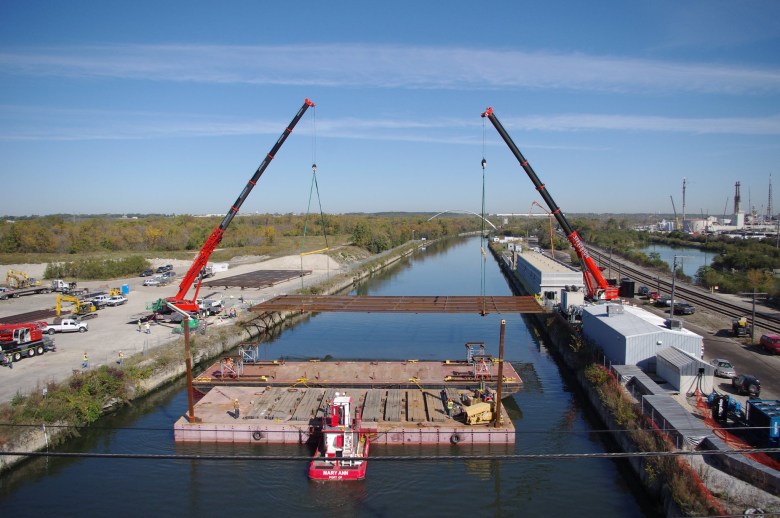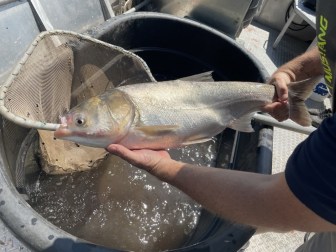Reading Time: 4 minutes
This story is a product of the Mississippi River Basin Ag & Water Desk, an editorially independent reporting network based at the University of Missouri School of Journalism in partnership with Report For America and funded by the Walton Family Foundation. Wisconsin Watch is a member of the network.
Federal and state agencies spend millions of dollars every year to keep destructive invasive carp out of the Great Lakes. Meanwhile, at least 25 destructive species — like water fleas and bloody red shrimp — are inching closer to the Mississippi River Basin.
Invasive silver carp have invaded nearly every part of the Mississippi River already, devouring plankton and leaving native fish like walleye, perch and whitefish to go hungry.
That’s what brings scientist Jim Lamer and his crew out on an electrofishing boat on the Illinois River on a warm summer day. There are more silver carp here than just about anywhere in the world. Lamer runs the Illinois River Biological Station in Havana, Ill., which is about 200 miles south of Chicago, just north of where the river meets the Mississippi near St. Louis.
“They’re voracious eaters,” said Lamer, “and they’re eating the base of the food web.”
That’s bad for fishers and bad for the ecosystem.
Invasive carp were introduced in the U.S. in the 1970s to control algae in aquaculture ponds. The fish began turning up in Illinois rivers in the 90s, but populations really took off in the mid-2000s. Now there are more carp than any other fish in the Illinois River and officials are trying to keep them out of the Great Lakes.
When Lamer’s team turned on the electrofishing boat, electric shocks shot out into the water and stunned carp flew several feet into the air, slapping the boat and water as they landed. A couple of them even landed in the boat.
These days, Lamer said, the carp are just part of everyday life. It’s the next big invader that he is worried about. “You hear reports of things starting to make their way from down south or up north,” said Lamer, “that could be the next one that could alter the food web or the abundance and diversity of the fish that we have here.”
Robert Hirschfeld has spent more than a decade studying the impact of aquatic invasive species in Illinois waters for the Prairie Rivers Network, a nonprofit advocacy group. He said silver carp are just one of many unwanted pests that could cause problems for the Illinois and Mississippi rivers.
“Carp have gotten most of the attention and most of the money in terms of invasive species,” said Hirschfeld. “But there are many other species that are threatening to come into Illinois waters.”
Species like the fishhook water flea and the bloody red shrimp — which could be even worse than invasive carp. Many of them hitch rides in the ballast water of ships that come through the Great Lakes St. Lawrence Seaway.
The U.S. Army Corps of Engineers is studying the problem. It issued the Great Lakes and Mississippi River Interbasin Study in 2014, which explored options for keeping invasive species from spreading between the two waterways. It found that 25 species could threaten the river ecosystems, which are some of the most biodiverse in the world.
Reuben Keller leads an aquatic invasive ecology lab out of Loyola University in Chicago, where he’s been researching the existing fail-safes preventing invasives from going back and forth between the Illinois River and the Great Lakes.
“We know that fishhook water flea, we know that bloody red shrimp, get to very high densities in Lake Michigan,” said Keller. “That gives us every reason to be concerned and to try and be proactive, keeping them out of other freshwater ecosystems.”
Species like the bloody red shrimp, seen here, threaten to spread into the Mississippi Basin and can hitch rides in the ballast water of ships that travel through canal locks. (Courtesy of National Oceanic and Atmospheric Administration)
The Army Corps has built massive shock barriers that cost millions of dollars a year to operate, in order to stun Asian carp and keep invasive fish out of the lakes. But fish aren’t the only threat.
Keller is investigating how well the barriers work against invertebrates — those little, sometimes microscopic, spineless organisms like quagga mussels, scud, water fleas and bloody red shrimp.
What he found is that the expensive barriers at the Chicago Sanitary and Ship Canal may keep carp out but invertebrates can still drift through. The electric zap doesn’t fully stun them.
“We know that invertebrates have moved through before,” said Keller, “and caused some really big problems … like the zebra and quagga mussels.”
Those species have killed off native mussels, a serious problem in Illinois where 25 of the state’s 62 native mussels are currently listed as threatened or endangered. Moreover, the zebra mussel has added up to costly problems by blocking up water intake pipes for power plants.
“We ought to be out there doing the science to try and figure out what the risks are,” said Keller.
 Components of an electric barrier designed to prevent the spread of invasive species are installed in the Chicago Sanitary and Ship Canal in Romeoville, Ill. on Oct. 8, 2010. (Jessica Vandrick / U.S. Army Corps of Engineers)
Components of an electric barrier designed to prevent the spread of invasive species are installed in the Chicago Sanitary and Ship Canal in Romeoville, Ill. on Oct. 8, 2010. (Jessica Vandrick / U.S. Army Corps of Engineers)
He said the risk such species pose to the Illinois and Mississippi rivers is unknown because there is not enough research being done, and not enough money is being spent to prevent potential catastrophes.
The U.S. Fish and Wildlife Service has developed a risk assessment program for aquatic invasive species across the Great Lakes, which has translated into a watch list of top priority invasive pests to combat. Presently, there is no parallel watch list for the Mississippi River basin.
Meantime, the Army Corps has launched another expensive project to keep invasives out of Lake Michigan: a nearly $900 million plan to upgrade a complicated series of locks and electric and acoustic barriers in Joliet, Ill.
The Army Corps has been authorized to address the interbasin transfer of aquatic species. But Congress has yet to direct funding to begin that study.
Hirschfeld said this leaves the basin with just another one-way solution. Projects like the one in Illinois might keep carp out of the lakes, but water fleas and other invertebrates will still pose a threat to the rivers.
“If we can spend billions, hundreds of millions on the Great Lakes,” Hirschfeld said, “where is the vision for our rivers, our inland rivers?”
The Great Lakes have a compact. They have a multi-state environmental initiative. That’s how advocates get millions of federal dollars to keep invasive species out. But the Mississippi River basin lacks an overarching management system. Environmental groups lobby to protect the basin and its natural resources, but it lacks a shared governance. Advocates say, without more resources, the Mississippi and its tributaries remain in uneasy waters.
This story is a product of the Mississippi River Basin Ag & Water Desk, an editorially independent reporting network based at the University of Missouri School of Journalism in partnership with Report For America and funded by the Walton Family Foundation.
The Desk wants to hear from you – share questions, tips, feedback or ideas with our newsrooms by emailing [email protected] or texting “MissRiver” to 73224.
Millions spent to keep invasive fish out of the Great Lakes, but who is protecting the Mississippi River? is a post from WisconsinWatch.org, a non-profit investigative news site covering Wisconsin since 2009. Please consider making a contribution to support our journalism.







